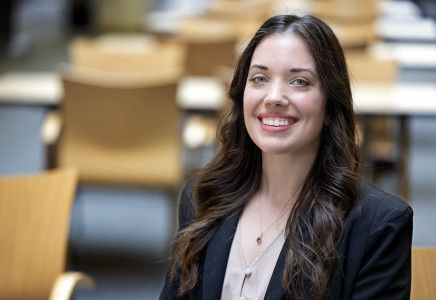Jefferson Lab photo/Aileen Devlin
Streamlining sustainability choices to minimize negative environmental impacts
Energy and sustainability specialist Aubrie Davie has her eye turned to the downstream effects of today’s choices. In her role at the U.S. Department of Energy’s Thomas Jefferson National Accelerator Facility, she has an increasingly visible position spearheading sustainability initiatives aimed at helping the lab minimize its environmental impact.
“We at the lab have to act responsibly,” Davie said, referring to the facility size as well as the carbon footprint of all materials and resources the lab uses.
“In 2022, we ran the Continuous Electron Beam Accelerator Facility (CEBAF) for 33 weeks, and we used around 205,000 megawatt hours of electricity for the year. By comparison, the average home uses about 10.6 megawatt hours per year. We’re a big facility, and we have to make sure we’re effectively managing resources and looking at what impacts our site has on our community.”
CEBAF is a DOE Office of Science user facility that supports the research of more than 1,800 nuclear physicists worldwide. Each run period for CEBAF is scheduled years in advance, so that nuclear physicists can make the most of the research data they collect.
Material matters
One area that Davie has been particularly attuned to is equipment sourcing. Instead of purchasing new equipment for each experiment, Davie advocates reusing equipment from previous experiments.
“We want to make sure we’re acquiring equipment that is used or that can be reused whenever possible,” she said. “There is a national shift that began with federal organizations about a decade ago and is trickling into the private sector that involves considering the downstream impact of all materials—the embodied carbon footprint. It’s asking about how much impact each part has on the environment and then making choices that minimize that impact.”
To that end, Davie reminds her teammates that where materials come from—and where they end up after they have been used—matters.
“We are constantly looking for ways to minimize what we send to a landfill,” she explains. “The first point of reference for how to manage used equipment is to ask: ‘Is there an option to send this to a facility that can reuse it?’ For this reason, equipment goes back and forth between national labs and university labs.”
When materials cannot be immediately repurposed, the lab may store them for a future project or look for ways to pass equipment through a certified recycling program, so that the materials will continue to have a life cycle.
Equipment trading post
With so much effort being put toward reusing materials, how do facilities communicate what equipment they have and what parts they need? Far from resembling a flea market or searchable catalog, labs largely rely on word-of-mouth to source used equipment.
“It's an intricate network and web that you weave when you are part of the national lab system,” Davie said. “There’s a lot of awareness within the scientific community about what other labs are doing. If there’s an opportunity to reuse equipment within the DOE, the DOE will facilitate that.”
While inter-lab equipment-sharing may rely on word-of-mouth, the lab does have its own internal outpost.
“Within the lab, we use a stock room website where teammates can search for supplies or cast-off equipment they’re not using so that the lab doesn’t have to buy something new if it’s not necessary. This includes things like extra office chairs, extra computer monitors—that sort of thing.”
Legacy unfolding
Each contribution toward being a more sustainable organization has added up to a heap of awards over the last few years.
“We consecutively win the GreenBuy gold level awards sponsored by the Energy.gov Office of Environment, Health, Safety and Security. We also have received awards across five product categories within the Electronic Product Environmental Assessment Tool (EPEAT) from the Global Electronics Council. This is a recognition that even though we rely on a massive amount of electronic services, like computers, display devices and printers, when we have to purchase new products, we are committed to purchasing products that are made more environmentally conscious,” she explains.
Davie emphasizes that the commitment to sustainability is organization-wide.
“We’re relying on our core values,” she said. “When making decisions that affect the environment, we rely on the bedrock principle of sustainability.”
Outside of work, Davie remains true to her core values, too.
“I believe deeply in what I do because I have a three-year-old daughter, and I’m so passionate about making sure we leave this world in a better place for her,” Davie said. “I care about sustainability on a personal and professional level equally. A lot of what I do when I’m not at work involves looking for ways to be more sustainable.”
Further Reading:
Jefferson Lab: Sustainability
Global Electronics Council Electronics Product Environment Assessment Tool
Office of Environment, Health, Safety and Security: GreenBuy Awards
By Carrie Rogers


